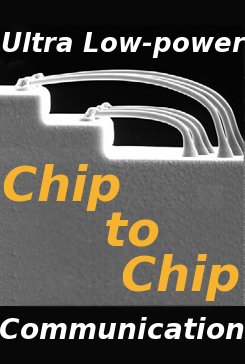Difference between revisions of "Low-power chip-to-chip communication network"
From iis-projects
(Created page with "thumb|250px ==Short Description== As individual chips grow in complexity and capability, their I/O requirements also...") |
|||
| (2 intermediate revisions by the same user not shown) | |||
| Line 1: | Line 1: | ||
[[File:Low-power chip-to-chip communication network.jpg|thumb|250px]] | [[File:Low-power chip-to-chip communication network.jpg|thumb|250px]] | ||
==Short Description== | ==Short Description== | ||
| − | + | One of the challenges of IC design is providing sufficient I/O bandwidth. This is even harder for smaller chips (like the ones relevant for our research) as there are usually not enough number of I/O pins to take advantage of parallelization. Most solutions center on fast serial communications. | |
| − | |||
| − | |||
| − | center on fast serial | ||
| − | |||
| − | + | In this work, we will assume that we have already an efficient serial interface (this is the topic of other ongoing projects). What we want is a way to connect two chips running [[PULP]] (or PULPino) systems over this fast serial interface so that they can exchange data with the minimum amount of energy consumption. There are several practical solutions from both academia and industry. Your job will be to investigate these methods, use/adapt/modify existing techniques or come up with a new method, add the necessary interface that will allow data to be transferred between two [[PULP]] chips, develop the HDL code for both the receiver and transmitter and make it work. The system should be an IP that seamlessly attaches to the [[PULP]] system. The final goal would be to add such an interface to an existing [[PULP]] system and tape it out as an ASIC. If successful, this will form the standard chip to chip communication standard for the [[PULP]] system. | |
| − | |||
| − | |||
| − | |||
| − | |||
| − | other | ||
| − | |||
| − | |||
| − | |||
| − | |||
| − | |||
| − | |||
| − | |||
| − | |||
| − | |||
===Status: Available === | ===Status: Available === | ||
| Line 40: | Line 22: | ||
---> | ---> | ||
===Character=== | ===Character=== | ||
| − | : | + | : 40% Theory |
| − | : | + | : 40% HDL Design |
| − | : | + | : 20% ASIC Design |
===Professor=== | ===Professor=== | ||
| Line 67: | Line 49: | ||
==Links== | ==Links== | ||
| + | * [http://www.adapteva.com/announcements/an-open-source-8gbps-low-latency-chip-to-chip-interface Adapteva low latency chip to chip interface] | ||
| + | * [http://bjump.org/ BaseJump.org] The UCSD BGA package and libraries from group of Prof. Michael Taylor | ||
[[#top|↑ top]] | [[#top|↑ top]] | ||
| − | |||
| − | |||
| − | |||
| − | |||
<!-- | <!-- | ||
Latest revision as of 12:34, 7 November 2017
Contents
Short Description
One of the challenges of IC design is providing sufficient I/O bandwidth. This is even harder for smaller chips (like the ones relevant for our research) as there are usually not enough number of I/O pins to take advantage of parallelization. Most solutions center on fast serial communications.
In this work, we will assume that we have already an efficient serial interface (this is the topic of other ongoing projects). What we want is a way to connect two chips running PULP (or PULPino) systems over this fast serial interface so that they can exchange data with the minimum amount of energy consumption. There are several practical solutions from both academia and industry. Your job will be to investigate these methods, use/adapt/modify existing techniques or come up with a new method, add the necessary interface that will allow data to be transferred between two PULP chips, develop the HDL code for both the receiver and transmitter and make it work. The system should be an IP that seamlessly attaches to the PULP system. The final goal would be to add such an interface to an existing PULP system and tape it out as an ASIC. If successful, this will form the standard chip to chip communication standard for the PULP system.
Status: Available
- Looking for 1-2 Semester/Master students
- Contact: Frank K. Gurkaynak
Prerequisites
- VLSI I
- VLSI II (recommended)
Character
- 40% Theory
- 40% HDL Design
- 20% ASIC Design
Professor
Detailed Task Description
Goals
Practical Details
Results
Links
- Adapteva low latency chip to chip interface
- BaseJump.org The UCSD BGA package and libraries from group of Prof. Michael Taylor
